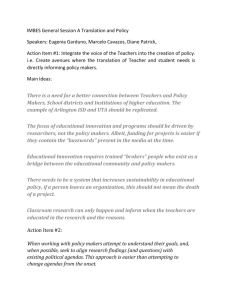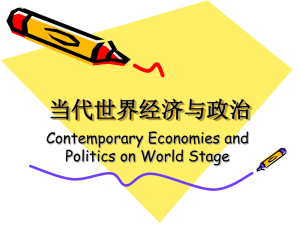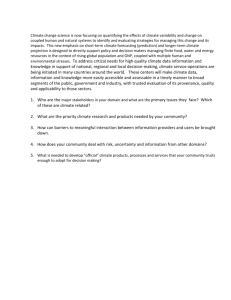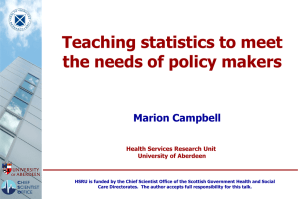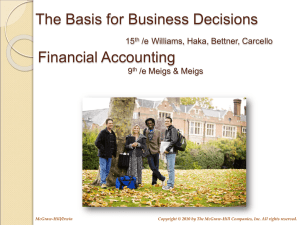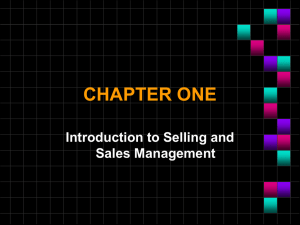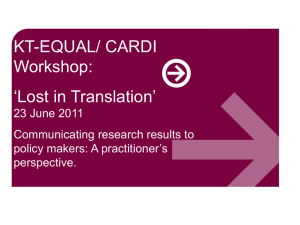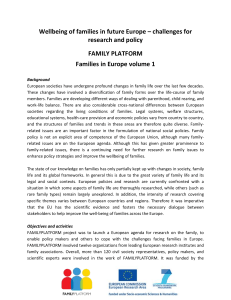Expertise - IOE EPrints
advertisement
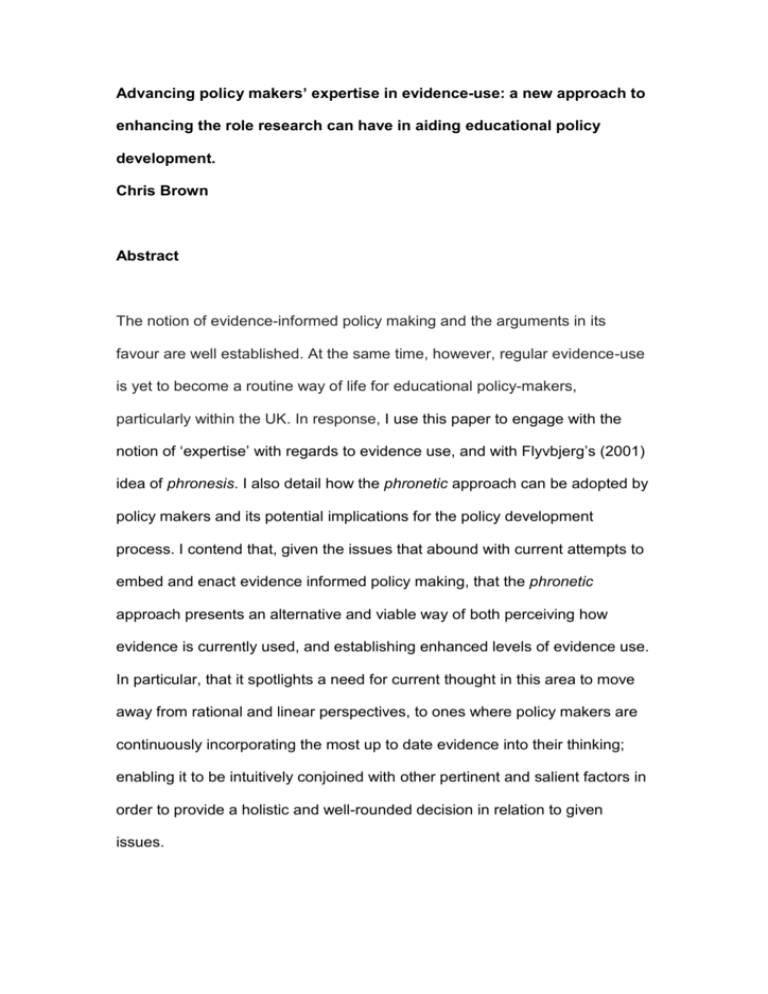
Advancing policy makers’ expertise in evidence-use: a new approach to enhancing the role research can have in aiding educational policy development. Chris Brown Abstract The notion of evidence-informed policy making and the arguments in its favour are well established. At the same time, however, regular evidence-use is yet to become a routine way of life for educational policy-makers, particularly within the UK. In response, I use this paper to engage with the notion of ‘expertise’ with regards to evidence use, and with Flyvbjerg’s (2001) idea of phronesis. I also detail how the phronetic approach can be adopted by policy makers and its potential implications for the policy development process. I contend that, given the issues that abound with current attempts to embed and enact evidence informed policy making, that the phronetic approach presents an alternative and viable way of both perceiving how evidence is currently used, and establishing enhanced levels of evidence use. In particular, that it spotlights a need for current thought in this area to move away from rational and linear perspectives, to ones where policy makers are continuously incorporating the most up to date evidence into their thinking; enabling it to be intuitively conjoined with other pertinent and salient factors in order to provide a holistic and well-rounded decision in relation to given issues. Introduction The notion of evidence-informed policy making and the arguments in favour of it are now well versed (e.g. Oakley, 2003; Temple, 2003). For example, Oakley argues that evidence-informed approaches ensure that “those who intervene in other people’s lives do so with the utmost benefit and least harm” (2000: 3); also described by Alton-Lee (2012) as the ‘first do no harm’ principle. Oxman et al. (2009), meanwhile summarise the benefits of policymakers adopting an evidence-informed approach as one that increases the probability of policy being more effective, equitable and efficient in terms of its value for money. There are a myriad of factors that influence policy development and the evolution of individual policies is heavily influenced by a multitude of factors. Gough (2004), for example, argues that policy-makers have a number of issues to consider in the development of policy, of which available research is only one. This view is shared by Lavis (2006) who maintains that debate surrounding the issues which merit government action, the most appropriate way to develop a policy in response, and how policies should best be implemented all take place within a highly complex environment. The position of research within these factors has been assessed (for example, by Davies, 2006, in his development of the policy ‘food chain’; also see Perry et al., 2010) From such analysis it is clear that, where evidence is considered, it usually sits (where these factors have been set out in a hierarchical order) towards the bottom of the pile in terms of importance. 2 There have been a number of specific initiatives instigated by UK Government, designed both to enhance Civil Servants’ understanding of the importance of evidence and to encourage its adoption and use when developing policy. These include the 1999 White Paper’s Modernising Government agenda, which outlines the need for policy to be based on high quality evidence, so that it is more responsive to the requirements of citizens; Professional Policy Making for the 21st Century (1999a), which identifies core competencies associated with good policy making and which emphasizes basing policy on ‘what works’; Adding it up (2000: 5), which seeks to provide a “comprehensive and coherent programme for creating the conditions in which rigorous analysis is routinely demanded and delivered”; and more recently, the Professional Skills for Government1 programme (launched in 2008) and the 2012 Civil Service Reform Plan.2 Professional Skills for Government formed a key part of the drive to reform the public services and aims to ensure that policy-makers have the skills required to deliver effective solutions; including the ability to identify and use ‘appropriate’ evidence. The Civil Service Reform Plan, meanwhile, included within it a commitment to the widest possible engagement with ‘external’ experts, and to investigate the feasibility of setting up an independent institution that might determine ‘what works’ with regards to social policy. 1 See: http: //www.civilservice.gov.uk/people/psg/index.aspx See: http://www.civilservice.gov.uk/wp-content/uploads/2012/06/Civil-Service-Reform-Plan-accfinal.pdf 2 3 Alongside these initiatives sit the requirement that departmental spending bids provide a supporting evidence base; the expectation that evidence used in all major policy decisions is made explicit; and the recommendation that more use is made of evaluated pilots as a pre-cursor to full policy implementation (Bullock et al., 2001). In terms of specific initiatives undertaken by the England’s Department for Education (DfE), the Government Office for Science report: Science and Analysis Review of the Department for Children Schools and Families (2010) also details a number of schemes run by the DfE in relation to improving the use of evidence. For example, the Making Policy Happen programme; designed to shift policy-makers’ behaviours towards a better consideration and use of evidence as part of their decision making. The Research Excellence Framework (REF) is the Higher Education Funding Council for England’s (HEFCE) new system for measuring both the quality and impact of research outputs from UK Universities. In describing the REF, HEFCE define impact as changes in the “the activity, attitude, awareness, behaviour, capacity, opportunity, performance, policy, practice, process or understanding”3 with regards to an “audience, beneficiary, community, constituency, organisation or individuals”. In recognition of the period of time it takes for evidence to have demonstrable impact, HEFCE suggest that the impacts that may be included within the January 2008 to July 2013 period (the assessment period covered by the 2014 REF) can be associated with research that was undertaken as far back as 1993. Correspondingly, it should now be possible to now ascertain whether the initiatives outlined above (many 3 http://www.ref.ac.uk/pubs/2011-02/ 4 of which are now some 13 years old) have had impact. In other words, whether they have affected the attitudes and awareness, or the activities, capacity or behaviours of policy makers with regards to evidence use, as well enhancing the opportunities policy-makers may have had to employ evidence. From assessing both current literature and my interview data, however, the short answer to this question would seem to be that their effects have been limited. For example, whilst a number of studies suggest that capacity to understand and consider evidence does, to an extent, exist at the level of the individual policy-maker level (e.g. see Campbell et al., 2007; author, 2009); Nutley et al. (2007) argue that the effects of those initiatives designed to improve evidence use across the Civil Service generally, have not been fully evaluated and are restricted to case studies and simple anecdotes of success. In addition, the Cabinet Office’s (2003) Trying It Out review of policy pilots across government found that, all too often, such pilots were quickly superseded by full policy rollouts (a message reinforced seven years later in Perry et al., 2010). Whilst Government Office for Science (2010) observes that, within the DfE “there is strong and active leadership support for evidence-based policy-making” (2010: 22), it also noted that Making Policy Happen is yet to be fully embedded and will require continued senior level support to become so. At the time of writing, however4, Making Policy Happen does not feature as an active initiative on the DfE’s website. In addition, between the publication of the Science and Analysis Review… and now, a number of the examples of 4 October 2012. 5 best practice spotlighted by Government Office for Science (and, which it was felt, served to enhance the DfE’s capability to engage with and use evidence) seem to have been discontinued. For instance the annual Research Conference is no longer referenced on www.dfe.gov.uk. Gone too are the annual Analysis and Evidence Strategies; the DfE’s annual statements of evidence requirements and priorities (e.g. see DCSF 2008, 2009). Lastly, but perhaps most tellingly in terms of the success of these initiatives, was the response by one former Secretary of State for Education I interviewed. Here it was noted that: “you come into government with better evidence-based policies than you’ve got after a year or 18 months”. This response thus implying that after initial bursts of enthusiasm, consistent use of evidence in the policy process is hard to maintain5. Why such approaches fail I suggest that there are a number of reasons why such initiatives are yet to take hold, particularly within educational policy making. The most pertinent of these include, for example, the notion commonly held by policy makers and some researchers that evidence is able to provide definitive ‘facts’ about the social world and in doing so describes the social world in its actual state (that they subscribe to broadly ‘realist positivist’ ontological/epistemological positions). The concomitant belief here is that, on the back of this evidence, policy can then be developed in order to successfully move the social world from where it is to where it ‘ought’ to be. Related to this is the idea that, if 5 Although this statement is may also reflect the changing attitudes of politicians to evince after a prolonged period of power (see Perry et al., 2010). 6 sufficient research is undertaken, then it will lead to the existence of tranches of evidence that might provide unequivocal direction or consensus (i.e. specific courses of action) with regards to particular issues.6 The existence of ‘objective’ evidence is, however, refuted by the constructivist perspective: in itself, this position is yet to be fully acknowledged or embraced by policy makers. Correspondingly, there tends to be disappointment on the part of policy makers when this unequivocal aid to action fails to materialize. (e.g. see Hargreaves, 1996; Tooley and Darby, 1998). As a result, research and researchers are then often sidelined in favour of others including special advisors, experts and those, such as think tanks, more willing to provide evidence that appears to be ‘policy ready’ (Davies, 2006). A second reason, and allied to the above, is the normative Habamassian notion that the process of policy making should be inherently rational in nature: i.e. which posits that the primary concern of all policy makers is to develop policies that are optimal in terms their efficacy, equity and value for money (e.g. Sutton 1999). As a consequence, such thought advocates the idea that policy makers not only routinely seek out evidence to aid this process but also engage with all pertinent evidence with regards to a particular issue. This notion is problematised in author 2012, where I illustrate how ‘policy agoras’ operate to exclude certain types of evidence from the policy development process. Closely aligned to this notion of rationality is that of linearity: the idea that policy development follows a linear progression that 6 Alternatively, if there is divergence of opinion within particular tranches of evidence, that any differences may be easily resolved by means of assessing the quality of evidence or by establishing a hierarchy of evidence based on methodological approach. 7 flows from the identification of an issue that needs solving to the delivery of a solution to that issue (Etzioni, 1967). Correspondingly, that the consideration of evidence will take place at given points within this sequence. I return to this point later in this paper. For the moment, however, I note that where linear approaches do not apply, then approaches to enhancing evidence use which rely on it, will fail to increase instances of evidence use by policy makers. A third point concerns the notion that, when developing policy, there is a need for separate and distinct roles and responsibilities between those who specify policy outcomes and those who consider what inputs might best deliver those outcomes (in other words that politicians can now often be seen to be both performing their role as well as that traditionally undertaken by Civil Servants). As I note in author 2012, instances of power abuse are more likely to occur when politicians dictate both the policy outcomes they desire AND the input mechanisms required to deliver them. Invariably, politicians are unlikely to be experts in the area for which they have responsibility. They will also be driven to deliver ideologically based mandates and to achieve a modicum of change before their short time in office is over7. Civil Servants, as professional policy makers, on the other hand, are likely to have spent more time in their given departments or immersed in specific subjects areas. They are also likely to be less partisan over given issues and more likely to be open to a range of alternatives that may deliver what the government of the day requires (see Mountfield, 1999). As a result, I argue that Civil Servants are likely to have a 7 Perry et al., (2010) for example, not that in the 33 years between 1976 and 2006 that there were 6 Secretaries of State with a responsibility for Education: this gives an average length of time in office of 2.06 years. 8 higher propensity to examine a range of evidence with regards to particular issues than politicians. They should thus be given more reign to do so. The last reason why these initiatives have failed to take hold is down to human nature. For example sociologists such as Paul Dowling (e.g. Dowling, 2005; 2007; 2008; 2008a) would suggest that the actions of social actors are geared towards alliance building. As such, when presented with policy problems to solve, civil servants, whether wittingly or unwittingly, may well choose the path of least resistance; picking solutions that they know might appeal and be quickly adopted, rather than presenting and defending a broader gamut of effective solutions. In addition, Michael Young (1958: 30-31) notes in ‘The Rise of the Meritocracy’ that parents: “as members of a particular family, they want their children to have every privilege. But at the same time they are opposed to privileged for anyone else’s children. They desire equal opportunity for everyone else’s children, extra for their own”. The same may be considered true of policy makers and evidence. As such, whilst it is hard not to concur that increased use of evidence is likely to bring benefits at some distant ‘societal’ level, the day to day grind of the policy process; the requirement to meet deadlines; the desire for promotion and so not to rock the boat (etc.) are all likely to combine in an attitude of ‘evidence-informed yes, but just not for my particular policy’. In other words to a desire not to stop and consider what evidence is saying (which may throw up difficult or unwanted messages), but instead to get the job done and to move on to the next task8. 8 This trend may be reinforced by the extent to which individual policy makers have capacity to engage with evidence and/or the extent to which evidence has been communicated effectively or in preferred and desired ways (such as the extent to which it has been made ‘policy ready’). 9 The points above raise a simple question: that if policy development does not occur in ways currently envisaged and if these blockages to evidence use truly exist, then why continue to try and facilitate evidence-informed policy making in ways that do not effectively address or account for them? My alternative is to posit the adoption of phronetic evidence use, which has its basis in the work of Bent Flyvbjerg. In particular in his 2001 thesis which examines the role of the social sciences and how they might be best harnessed to deliver “enlightened political, economic, and cultural development” in society (2001: 3). Flyvbjerg posits that this is best achieved by employing a contemporary interpretation of Aristotle’s notion of phronesis; something often translated as ‘practical wisdom’. I now use the remainder of this chapter to examine in detail Flyvberg’s notion of phronetic expertise and how this might apply to the use of evidence by educational policy makers. Correspondingly, therefore, I assess if and how phronesis might tackle some of the key issues I describe above. Phronetic expertise Flyvbjerg employs the ‘Dreyfus’ model of learning to illustrate what he means by expertise. The Dreyfus model employs five ‘levels’ of human learning, ranging from novice to expert9, with each level comprising recognisably different behaviours in relation to performance at a given skill. A novice, for example is new to particular situations; will, during instruction, learn about 9 These levels are i) novice; ii) advanced beginner; iii) competent performer; iv) proficient performer and v) expert. 10 facts corresponding to and other characteristics pertaining to the situation and so is taught or develops ‘rules for action’. Flyvbjerg suggests that for the novice: Facts, characteristics, and rules are defined so clearly and objectively… that they can be recognised without reference to the concrete situations in which they occur. On the contrary, the rules can be generalised to all similar situations, which the novice might conceivably confront. At the novice level, facts, characteristics, and rules are not dependent on context: they are context independent (2001:11). This is nicely illustrated through the example of learning to drive 10, which comprises theoretical rules for action (the rules of the road) along with more practical instructions: e.g. what constitutes the biting point of gears; the process of moving through gear changes and so on. Both can be learnt independently of any ‘concrete’ situation. Over time, however, as the driver becomes more familiar with instances in which they change gears, this process becomes more intuitive. Flyvbjerg argues that as learners advance from ‘novice’ and through the levels of ‘advanced beginner’, ‘competent performer’ and ‘proficient performer’, that a number of things occur to facilitate the normalisation of this instinctual/intuitive behaviour: firstly instances of performing in real life situations increase, correspondingly the number of 10 Learning to cross the road also provides an excellent example. The ‘Green Cross Code’, for instance sets out five specific rules with regards to crossing the road safely (see: http://www.dft.gov.uk/think/education/early-years-and-primary/parents/7-to-11s/the-green-crosscode/). These soon make way for intuition and expert judgement, however, as the need for safety becomes augmented with the need to cross quickly. 11 ‘cases’ that the learner encounters and tackles also increases; secondly, recognition of different situations accumulates, as does recognition of the context in which those situations occur; thirdly, dependency on specific ‘rules for action’ diminishes as learners are able to interpret and judge how to perform optimally in any given situation (for example, when the noise of the engine, rather than rules of thumb concerning speed, indicates that it is time to change gear).11 Genuine expertise, however, only occurs as the result of ‘quantum leap’ in behaviour and perception; from that of an analytical problem solver to someone who: “[exhibits] thinking and behaviour that is rapid, intuitive, holistic, interpretive… [expertise] has no immediate similarity to the slow, analytical reasoning which characterises rational problem-solving and the first three levels of the learning process” (Flyvbjerg, 2001:14). In other words, experts immediately perceive a situation: the problem that is presented, the goal that must be achieved and the actions that will address this; without need to divide this process into distinct phases. This, Flyvbjerg argues is “the level of true human expertise. Experts are characterised by a flowing, effortless performance, unhindered by analytical deliberations” (2001: 21). Whilst Flyvbjerg presents an effective and compelling understanding of what expertise is, what is also required are practical suggestions for how social actors might reach this level of phronesis. Vital too for an analysis of evidence use is how policy-makers might engage with formal knowledge once this 11 Often this occurs through trial and error. It will also occur in conjunction with learners understanding how to prioritise between rules and experience and when they might begin to disregard specific instances of the former in favour of the latter. 12 status has been reached. Clues to these two points can be found in the work of others who have examined this subject. Stewart and Liabo (2012), for example, suggest that the type of instinctual or intuitive action described by Flyvbjerg is made possible because expertise is enacted via knowledge which is both formal and informal. This analysis provides an important differentiation between knowledge that might be considered explicit and other knowledge; that which we simply come to ‘know’. Similarly, Polanyi (1958) arguing from a ‘constructivist’ perspective, notes that formal or ‘explicit’ knowledge never simply exists but always rests on a much larger, hidden, foundation of ‘tacit’ knowledge (which can have as its basis either a practical or cogitative element). This tacit knowledge, whilst it cannot always be articulated, provides the basis for how we come to ‘know’ explicit knowledge. In other words it provides a lense or a mechanism through which we come to view or engage with all other forms of knowledge. Collins and Evans (2007) too highlight the importance of tacit knowledge, suggesting that it is the type of 'deep' understanding that is required for expertise. Collins and Evens argue, however, that tacit knowledge is socially facilitated. As such, they suggest that successfully acquiring tacit knowledge requires individuals to effectively embed themselves within the social group and situations which embody the expertise in question. Similarly, maintaining tacit knowledge requires continual immersion with such the groups/settings. It is my argument, therefore, that it is the type of virtuoso performances described by Flyvbjerg that are required by policy makers when it comes to evidence use. I augment this analysis, however, by suggesting that such performances will occur when social actors have fully developed and maintain the type of intuitive or deep understanding 13 required for them to ‘know’ formal knowledge. In itself this will stem from both immersion within formal knowledge and with others who are experts in producing or using evidence (or both). Phronesis in relation to evidence use When it comes to evidence use as currently conceived, however, Civil Servants would appear both to be positioned and to act, at the level of novice. For example, linear perspectives regarding how evidence is used posit that there will be fixed points at which evidence will or should be consulted in order to inform policy (see Etzioni 1967). It is noted by Sutton for example that: Variously called the linear, mainstream, common-sense or rational model, this model is the most widely-held view of the way in which policy is made. It outlines policy-making as a problem solving process which is rational, balanced, objective and analytical. In the model, decisions are made in a series of sequential phases, starting with the identification of a problem or issue, and ending with a set of activities to solve or deal with it. (1999: 9) In other words that evidence is not regarded as something to be considered intuitively or holistically but separately as part of a defined, rationalised, sequence of events. This notion is reaffirmed when we examine the kinds of evidence requested and privileged by Civil Servants, which is often akin to the knowledge that may be found in an instruction manual. For example evidence 14 that details ‘what works’; i.e. that provides generic, context independent rules of thumb (which can be applied to any situation: e.g. to all classrooms or schools); or evidence that is ‘policy ready’ (see author 2012a): that is, evidence which has been transformed so that it provides a specific guide to action. In both cases, this type of evidence can be directly applied against potential plans for action or used to pinpoint solutions in themselves. In addition, this type of evidence is easily digested, simplistic in nature and thus frequently doesn’t require more than cursory engagement or interpretation in order for it to be employed. In fact, the more esculent the evidence, the more likely its ‘use’ can be limited to a simple acceptance/rejection of the recommendations or solutions presented. For example, should it point to a solution that is not cost effective or impractical to implement, then this type of evidence is likely to be dismissed out of hand. A more valuable engagement, however, would see policy makers taking into account the basic or underlying principles of the message in question and for these to become intertwined with other situational variables in order to produce a solution (also see Ball, 1994). Whilst the novice-level use of ‘what works’ or ‘policy ready’ evidence might be appropriate in solving well specified tasks, where the solution is equally well defined and understood, it is less well suited to situations in which the task is complex, where the solution needs to incorporate a multitude of factors (including the economic and ideological) and where any solution proposed will be scrutinised by the media and critiqued by those with vested interests in its outcome. In other words, when it comes to the process of policy making as it 15 actually occurs. True expertise in evidence use (which I will call phronetic evidence use), on the other hand, provides a vision of policy makers as social actors who intuitively develop responses to situations: with this intuitive holistic reading based on an amalgamation of the formal knowledge they have adopted to date, an understanding of the specific case they are dealing with and their understanding of the other environmental factors that might be influence the policy decision (e.g. the amount of money that is available; the ideological perspectives of the Ministers initiating the policy; how the press/public might respond; who might try and block its implantation; those stakeholders who might need to be courted; the capacity of available delivery mechanisms to ensure that the policy is implemented on the ground, and so on). This then moves conceptions of how policy makers should engage with evidence away from something separate and temporally specific, to something which is fully and continuously integrated. My proposed way forward, therefore, is to suggest that policy makers, as an essential element of their role, continually engage with research and researchers (with such immersion enabling them to build and maintain expertise in evidence use).12 Such engagement means that, when it comes to a specific issue, policy-makers will have based as many decisions as possible on as solid a footing as possible (i.e. in terms of what the evidence suggests). This is not to say that other research may not be required or used to fine-tune understanding or to evaluate pilots as the process develops, but it does mean that, even where this is not employed or arrives too late to have any material 12 That is, using the terminology of Dowling, that policy-makers seek to constantly create alliances and so positive relationships with research and researchers rather than disunions. 16 impact (or when the policy priorities have bypassed the desire for the research), all other decisions will have been as evidence informed as they might be13 The implications of adopting the phronetic approach The notion of phronetic evidence use is far removed from the traditional, linear conception of evidence use in policy-making briefly touched upon above. As well as illustrating what might be, however, I argue that the phronetic approach actually represents a more realistic conception of evidence use as it currently stands. For example, extant models implicitly assume that the mind of the policy maker will be ‘empty’ of knowledge in relation to a given issue until they have been provided with evidence in relation to it. Patently, this cannot be true: policy makers will have considered opinions, are likely to have an understanding of the wider policy environment and may have already digested research in relation to a given issue before they are specifically required to tackle a given problem. As such, adopting a phronetic approach illustrates the fallacy of conceiving of evidence use as something separate from policy development: that instead, we must recognise that policy-makers and their decisions will already be (explicitly or implicitly) informed by every facet that has shaped their perspective/reality to date (i.e. see Chapter 5); including the evidence and knowledge they have already adopted. 13 In this sense, the notion of phronetic evidence use tackles the mismatch in evidence and policy production cycles that has all to often been held up as a stumbling block for why further instances of evidence-informed policy making have failed to materialise. 17 As well as better explaining how the use of evidence by policy makers currently operates, I also argue that the phronetic approach presents a more effective way of accounting for some of the issues I outline above, which serve to prevent increased instances of evidence use. For example, I have already noted how continuous engagement with research means that policy decisions are not contingent on evidence being considered at a fixed point in time in order for them to be considered ‘evidence-informed’. In addition, this position also provides a much needed ‘constructivist’ alternative to the dominant ‘realist positivist’ perspective: rather than policy makers rely on or await tranches of evidence to provide direction, policy makers instead will develop their own understanding of the evidence base and draw their own implications (in terms of ‘what works’) from it. At the same time, how evidence is interpreted and whether it is adopted, rather than solely a function of ‘rational’ engagement, will be driven by the perspectives developed by policy makers over time and the realities that they inhabit. This means that rather than assuming notions of quality and the methodology employed will be the key determinants as to whether evidence will be used, they will instead sit alongside notions such as how well the story ‘resonates’ with policy makers (something alluded to by Huberman, 1990). In addition, as policy makers develop a picture of the evidence base over time, so the dangers of power abuse will diminish. This is because policy makers are less likely to be faced with situations where they will be required to accept/reject the findings of a particular study in relation to a policy decision. Instead their decisions will be steeped in a rich bank of evidence; of which some (depending upon their time in post) will have its origins in a multitude of past policy agoras, corresponding 18 to a wealth of ideological positions held by previous governments. This is not to say that, with the adoption of phronetic expertise, the policy agora no longer operates, simply that its power to affect decision making will be reduced14. A graphical illustration of my notion of phronetic evidence use is set out in Figure 1, below. Here use of evidence is not set out as a separate function but forms part of the left hand box: policy makers’ intuitive and holistic reading of a given situation. To ensure that this reading includes pertinent and current evidence requires a constant engagement with research outputs (the horizontal arrow) and, in itself, this requires capacity on the part of policy makers. The model also recognizes the constructivist nature of social action by setting out policy makers’ interpretative lense. Thus, evidence (if it is used) will not necessarily be interpreted the same way as researchers intend it to be. The interpretative lense may also prevent policy makers fully engaging with that evidence which doesn’t conform to their given perspective on a particular issue (or conversely, may lead to them championing evidence which does). What is important to note within this model then, is that the successful establishment of phronetic evidence use requires not only constant engagement but also the ability to constantly engage with evidence. 14 As noted above, for power abuse to be minimized further, there needs to be a better separation of roles and responsibilities between politicians and Civil Servants, with regards to inputs and outcomes (see Chapter 8). 19 Figure 7.1: Phronetic expertise in evidence use Addressing potential critique of the phronetic approach A first area of potential critique of my proposed approach relates to transparency: to the idea that we would like to know what research policy makers have considered as part of their decision making. My response here is threefold. Firstly, whilst we may in any model of policy making come to understand what evidence has been considered by policy makers, we are unlikely to ever come to know how it was interpreted by them or the myriad of factors that affect this interpretation. Secondly, I regard phronetic evidence use as stemming from a very formal process of engagement with evidence (e.g. the type of engagement you might expect from a medical practitioner and the way in which they approach their professional development). It is 20 problematic, however, to assume that the provision of knowledge can by itself deliver or lead to expertise in evidence use (Hackley, 1999; Stewart and Liabo, 2012). As such, this process of engagement would be fully related to increasing policy makers’ capacity to understand research, to the requirements of the competencies needed by Civil Servants to undertake their role and also to the relationships government departments have with Higher Education Institutions (HEIs)s. In other words, I am suggesting that, whilst a given policy decision doesn’t need to contain within it a formal point in which evidence is introduced, that policy makers’ engagement with evidence becomes essentially more systematic, regular and rigorous and that this process and the types of evidence digested by policy makers as part of it could be laid open to inspection. Thirdly and finally, the phronetic approach doesn’t negate notions of challenge and accountability: i.e. I am not advocating ‘black box’ policy making, where decisions are made but Civil Servants do not have to justify them. Civil Servants are not surgeons; their decisions are not required to be made in a split second and are rarely final or immediately binding. It is possible, therefore, to introduce/maintain checks and balances in the policy development process. Here interpretations of evidence could be questioned, counter arguments put forward and so on. A second point concerns perceptions that the type of ‘intuitive’ expertise I am discussing here might be thought of as ‘unscientific’ or ‘irrational’; but if a conventionally rational approach is not applied to a situation, this does not mean that the outcome is ‘irrational’. Flyvbjerg notes that we are familiar with instances of phronetic expertise where the intuitive reading of situations is of 21 the type undertaken by footballers, athletes, jazz musicians and so on; especially where these social actors have moved beyond the level of analytical planning and execution typified by competent performers to that of virtuoso. Even in areas such as medicine, professional diagnosis has been described as: “a skill more closely allied to the skill of a connoisseur examining a picture or an old violin than it is to what we normally think of as science” (Lord Platt, physician, 1972: 26). An example more akin to policy making is, perhaps, that of marketing: the marketing process is rarely branded irrational, despite it primarily comprising activities steeped in phronetic expertise and decision making. As Hackley notes: “the highest levels of expertise in this domain, as in other professional domains, depend upon an interaction of domain relevant knowledge, experience and creativity” (1999: 722). Thus marketers, for example those launching a new product, intuitively recognise what features of the product should be promoted in order to maximise demand. Marketers must also have an eye for what makes a visually appealing campaign that enflames desire and that hits the right ‘spot’ amongst target consumers and also how and through which channels such a campaign will be promoted. Evidence use is key to effective marketing (in particular to testing or piloting ideas and to evaluating the impact of campaigns); but marketers don’t simply allocate fixed points throughout the development of a marketing campaign in order to consider market research: successful marketers constantly engage with evidence before, throughout and after specific activity. This enables, as Hackley (1999: 729) argues, marketers to possess “intuitive sensitivity to market changes” and the “intuitive ability to draw predictive inferences from [evidence] to form dynamic real-world 22 hypotheses” As a result, marketers will often argue that a successful campaign comes from the ‘gut’; that after years of understanding their market place and the consumers within it, of knowing what sells and what is appealing, that they can intuitively and instantaneously conceive of well honed campaigns that address their aims and maximise sales (and that this is bourn out in the success of those campaigns, both in terms of what the market research says and in terms of units sold). Flyvbjerg argues that “the rationalist perspective focuses on those properties of human activity by which humans most resemble machines or Weberian bureaucrats: rule-based deliberation based on formal logic” (2001: 22). In this sense, like marketing, policy-making rarely comprises such ‘mechanical’ operation; as such, any application of a similar logic to evidence use as part of it is likely to result in the sub-optimal outcomes noted above (i.e. that evidence is not used as well as it might be). In addition, my approach doesn’t tackle, but rather accepts that evidence can never be imported in a ‘perfect’ state into policy. Ultimately, therefore, the outcome of my posited approach is to suggest that effective evidence use is simply represented by the interpretation of evidence by policy makers and its intuitive conjoin with an amalgamation of the other factors that comprise their given constructed reality (i.e. that it has been adopted by them). This is, perhaps, a difficult message to accept, because it means that evidence use cannot readily (or accurately) be measured or always properly accounted for. We are unlikely to ever truly know which studies (or aspects of studies) rang true and which didn’t. Moving forward, it also means accepting vagueness and not knowing (as a researcher) if your study will have salience or not 23 (which may in part be luck of the draw: i.e. dependent on it reaching the ears of a policy maker who shares a similar perspective to you). All of which are less attractive and less easy to find comfort in than rationality and linearity. Lastly, I also recognise that, as it currently stands, my posited approach cannot tackle some of the issues associated with human nature, detailed above: even if Civil Servants constantly engaged with evidence, politicians would still be likely to require a say over how outcomes are to be achieved; Civil Servants are also likely to be weary of always fighting in favour of their own solutions to achieving those outcomes. In addition, Civil Servants may also, if it suits their wider agenda (e.g. their career aspirations) still recommend the inputs that are most harmonious with the ideology of the day, rather than those which are most effective in reaching the outcomes specified by Ministers. In part, some of these issues are dependent upon how well the approach is implemented. Conclusion As a result of engaging with Flyvbjerg’s notion of phronesis I argue that our conceptions with regards to evidence-informed policy making and how instances of evidence use can be enhanced, need to move away from rational and linear perspectives, to ones where policy makers are (as a consequence of their constant engagement with research) continuously incorporating the most up to date evidence into their thinking. This knowledge will then be intuitively conjoined with other pertinent and salient factors in order to provide a holistic and well-rounded decision in relation to a given issue. This suggests 24 a fundamentally different approach to informing policy making, since it requires constant rather than sporadic engagement by policy makers with research outputs. As I have shown above, however, such a conception does serve to addresses some of the key issues that are often held up as reasons for why evidence-informed policy making is yet to truly take hold in education. 25 Methodological appendix This paper has at its core, a research project undertaken between 2009 and 2011 (author, 2011). As such, it seems prudent to provide sufficient detail as to the method employed by this study to enable readers to judge the validity of my conclusions. At the same time, however, I have attempted to keep this section as innocuous as possible and so direct those requiring further information to Section 4 (p.89) in author (2011). Part 1: a ‘configurative’ literature review The first part of my methodological approach comprised a literature review. The aim of the review was to provide an overview of existing theory and an understanding of the type of empirical studies previously undertaken in this area. Whilst systematic in approach, the primary requirement of the review was for it to provide general understanding, rather than a comprehensive assessment of empirical evidence. This corresponds with a ‘configurative’ rather than ‘aggregative’ approach to reviewing literature (Sandelowski et al., 2011; Gough et al., 2012). Literature was initially searched for in two ways: i) A search of four prominent databases15 using search terms synonymous with that of ‘evidence-informed policy making’ and 'knowledge adoption'16; and ii) recommendations on seminal literature were also sought from (and provided by) colleagues, authors identified from the search above, and experts in the 15 These were JSTOR; Academic Search Complete; Web of Knowledge; IngentaConnect These included, for example, 'knowledge mobilisation', 'knowledge transfer' and 'knowledge brokering', and were taken from the definitive list provided on The University of Toronto's Research Supporting Practice in Education website (http://www.oise.utoronto.ca/rspe/KM_Products/Terminology/index.html) 16 26 fields of evidence-informed policy making and knowledge adoption. The references cited by the authors of these studies were then also reviewed. These three approaches to sourcing literature, combined with the screening criteria, resulted in a total of 228 papers, studies, reports and books being reviewed over a one and a half year period. Part 2: in-depth, semi-structured interviews In augment the findings of the literature review, 24 semi-structured, in-depth interviews were held with educational researchers and policy-makers working in England and Wales. Those classed as policy-makers were either politicians (current or ex-Ministers) or Civil Servants in central government. Researcher respondents comprised those working for Universities or think tanks. Whilst a purposeful sample of ‘critical cases’, corresponding directly to the analytical requirements of the project were selected (Brown and Dowling, 1998), care was taken to include both advocates and those critical of current approaches to develop and embed evidence-informed policy. This provided a wide range of views and opinions from which to draw upon and assess. It also provided a rigorous critique of the analysis and its resultant conceptual/theoretical development. The distribution of the final participants is presented below (note the number adds to more than the total interviewed as these groups are not mutually exclusive): 27 Table 1: Distribution of interview participants Group/view point Number Politicians based in England and Wales 2 Civil servants based in England and Wales 4 Researchers considered from the literature, or self 9 identified, as favoured by politicians or Civil Servants Researchers considered from the literature, or self 6 identified, as less favoured by politicians or Civil Servants Academic researchers critical of the concept of evidence- 4 informed policy Academic researchers in favour of evidence-informed 11 policy Respondents belonging to think tanks, political advisors or 3 those operating at the higher levels of Davies’ (2006) policy making ‘food chain’ Total 24 Following the interviews, thematic analysis was employed to identify the key evidence-informed or knowledge adoption-related behaviours that were or might be employed by researchers. Themes and codes were developed empirically through the breakdown of the data generated in the interviews. Empirical coding may be regarded synonymous with inductive analysis; that is, where data analysis precedes the development of theory. Theoretical development within the study began, however, with the literature review and 28 was thus augmented rather than initiated during the data analysis stage. This approach corresponds to Mason’s (2002: 180) definition of ‘abductive’ analysis where “theory, data generation and data analysis are developed simultaneously in a dialectical process”. Mason’s (2002) posited approach thus accounts for the way in which the research process moved back and forth between analysis and the development of theory, detailing themes and constructing codes relating to knowledge adoption from both the interview data, and the literature review. 29 References Author 2009 Author 2011 Author 2012 Alton-Lee, A. (2012). The use of evidence to improve education and serve the public good. Paper prepared for the New Zealand Ministry of Education and the annual meeting of the American Educational Research Association, Vancouver Canada, April 2012. Aristotle. (1976) The Nicomachean Ethics, (Harmondsworth, Penguin). Ball, S. (1994) Intellectuals or technicians? The urgent role of theory in educational studies, British Journal of Educational Studies, 43, 3, pp255-271. Brown, A., and Dowling, P. (1998) Doing Research/Reading Research: A mode of interrogation for education, (London, Falmer Press). Bullock, R., Mountford, J. and Stanley, R. (2001) Better Policy making, (London, Cabinet Office). Cabinet Office. (1999) Modernising Government (London, TSO). 30 Cabinet Office. (1999a) Professional Policy Making for the twenty first century, (London, TSO). Cabinet Office (2000) Adding it up: Improving analysis and modelling in Central Government. A Performance and Innovation Unit report, (London, HMSO). Cabinet Office (2003) Trying it out: The role of ‘pilots’ in policy making: Report of the review of government pilots, (London, Cabinet Office). Campbell, S., Benita, S., Coates, E., Davies, P., and Penn, G. (2007) Analysis for policy: evidence-based policy in practice, (London, HM Treasury). Collins, H., and Evans, R. (2007) Rethinking expertise (London, University of Chicago Press). Davies, P. (2006) Scoping the Challenge: A Systems Approach, National Forum on Knowledge Transfer and Exchange Toronto Canada, 23-24 October 2006, available at: http://www.chsrf.ca/migrated/pdf/event_reports/philip_davies.ppt.pdf, accessed 14 August 2012. Department for Children Schools and Families (2008) Analysis and Evidence Strategy 08-09, (London, DCSF). 31 Department for Children Schools and Families (2009) Analysis and Evidence Strategy 09-10, (London, DCSF). Dowling, P. (2005) Treacherous Departures, available at: http://www.pauldowling.me/publications/Chapter%204.pdf, accessed 1 August 2012. Dowling, P (2007) Organizing the Social, available at: http://www.pauldowling.me/publications/dowling2007.pdf, accessed 1 August 2012. Dowling, P. (2008) Unit 4 Generating a research question, in Research and the Theoretical Field Lecture Pack and Reading Pack, (London, University of London). Dowling, P. (2008a) Mathematics, Myth and Method: the problem of alliteration. Available at: http://www.pauldowling.me/publications/dowling2008a.pdf, accessed 1 August 2012. Etzioni, A. (1967) Mixed Scanning: a third approach to decision making, Public Administration Review, 25, 5, pp385-92 Flyvberg, B (2001) Making Social Science Matter: Why Social Inquiry Fails 32 and How it Can Succeed Again, (Cambridge, Cambridge University Press). Hackley, C. (1999) Tacit knowledge and the epistemology of expertise in strategic marketing management, European Journal of Marketing, 33, 7/8, pp. 720-735 Government Office for Science. (2010) Science and Analysis Review of the Department for Children Schools and Families, (London, Government Office for Science). Gough, D., Oliver, S., and Thomas, J. (Eds.) (2012) An introduction to systematic reviews, (London, Sage). Hargreaves, D. (1996) The Teaching Training Agency Annual Lecture 1996: Teaching as a research based profession: possibilities and prospects, available at: http://eppi.ioe.ac.uk/cms/Portals/0/PDF%20reviews%20and%20summaries/T TA%20Hargreaves%20lecture.pdf, accessed on 13 August 2012. Her Majesty’s Treasury (2004) Choice for parents, the best start for children: a ten year strategy for children, (Norwich, HMSO). Her Majesty’s Treasury (2007) Policy Review of Children and Young People: a discussion paper, (London, HMSO). 33 Huberman, M. (1990) Linkage between researchers and practitioners: A qualitative study, American Educational Research Journal, Summer, pp. 363391. Lavis, J. (2006) Research, Public Policymaking, and Knowledge-Translation Processes: Canadian Efforts to Build Bridges, The Journal of Continuing Education in the Health Profession, 26, pp. 37-45. Mason, J. (2002) Qualitative Researching, (London, Sage). Mountfield, R. (1999) “Politicisation” and the civil service, available at: http://www.civilservant.org.uk/politicisation.pdf, accessed 5 September 2012 Nutley, S.M., Walter, I. and Davies, H.T.O. (2007) Using evidence: How research can inform public services, (Bristol, The Policy Press). Oakley, A. (2000) Experiments in knowing: gender and method in the social sciences, (Cambridge, Polity Press). Oakley, A. (2003) Research Evidence, Knowledge Management and Educational Practice: early lessons from a systematic approach, London Review of Education, 1,1, pp. 21-33 Ouimet, M., Landry, R., Ziam, S., Bedard, P-O. (2009) The absorption of research knowledge by public civil servants, Evidence and Policy: A Journal 34 of Research, Debate and Practice, 5, 4, pp. 331-350. Oxman, A., Lavis, J., Lewin, S., and Fretheim, A. (2009) SUPPORT Tools for evidence-informed health Policymaking (STP) 1: What is evidence-informed policymaking?, available at: www.health-policy-systems.com/content/7/S1/S1, accessed on 14 November 2010. Perry, A., Amadeo, C., Fletcher, M., Walker, E., (2010) Instinct or Reason: How education policy is made and how we might make it better (Reading, CfBT). Platt, Lord. (1972) Private and controversial (London, Cassell). Polanyi, M. (1958) Personal Knowledge. Towards a Post Critical Philosophy (London, Routledge). Rickinson, M., Sebba, J. and Edwards, A. (2011) Improving research through user engagement, (London: Routledge). Sandelowski, M., Voils, C., Leeman, J., Crandell, J. (2011) Mapping the Mixed Methods–Mixed Research Synthesis Terrain, Journal of Mixed Methods Research, available at: https://portal.ioe.ac.uk/http/mmr.sagepub.com/content/early/recent, accessed on 7 January 2012. 35 Sylva, K., Taggart, B., Melhuish, E., Sammons, P. and Siraj-Blatchford, I. (2007) Changing models of research to inform educational policy, Research papers in Education, 22, 2, pp. 155-168. Stewart, R., and Liabo, K. (2012) Involvement, expertise and research quality: a new model of public and patient involvement in research, Journal of Health Services Research and Policy, 18. Sutton, R. (1999) The policy process: an overview, available at: http://www.odi.org.uk/resources/docs/2535.pdf, accessed on 12 October, 2012. Temple, P. (2003) Educational Research and Policymaking: findings from some transitional countries, London Review of Education, 1,3, pp. 217-228 Tooley, J. and Darby, D. (1998) Educational Research: a Critique, (London, Ofsted). Young, M. (1958) The Rise of the Meritocracy, (London, Thames & Hudson). 36
